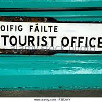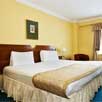Tourist attractions in Derry
As well as excellent tours around the city and its 17th Century walls, Derry also boasts a number of excellent visitor attractions. The Tower Museum is an award winning attraction, telling the history of the city and includes a range of exhibitions, while Derry's Guildhall, St Columb's Cathedral, St Eugene's Cathedral and St Augustine's Chapel are all historic buildings of stunning architecture.
Other sights include the fascinating Bogside Murals found on the walls of what is known as Free Derry Corner and depict various events in the history of the town, from the Nationalist perspective. A more contemporary sculpture in the city, known as Hands Across the Divide, serves as a symbol of the two communities coming together.
The city walls are the best-preserved in all of Ireland and make about a one-mile circumference around the city centre.

Image: Derry's Guildhall
City Walls
Derry is the only remaining completely intact walled city in Ireland and one of the finest examples of a walled city in Europe. The walls constitute the largest monument in State care in Northern Ireland and, as the last walled city to be built in Europe, stands as the most complete and spectacular.
The Walls were built during the period 1613-1618 by "the honourable the Irish Society" as defences for early 17th century settlers from England and Scotland. The Walls, which are approximately 1 mile (1.5 km) in circumference and which vary in height and width between 12 and 35 feet (4 to 12 metres), are completely intact and form a walkway around the inner city. They provide a unique promenade to view the layout of the original town which still preserves its Renaissance style street plan. The four original gates to the Walled City are Bishop’s Gate, Ferryquay Gate, Butcher Gate and Shipquay Gate to which three further gates were added later, Magazine Gate, Castle Gate and New Gate, making seven gates in total. Historic buildings within the walls include the 1633 Gothic cathedral of St Columb, the Apprentice Boys Memorial Hall and the courthouse.
It is one of the few cities in Europe that never saw its fortifications breached, withstanding several sieges including one in 1689 which lasted 105 days, hence the city's nickname, The Maiden City.
Bogside
Take a walk around the "Free Derry" corner between the Bogside and the western side of the old city walls. Stop and look at the political murals made by local artists during the 90's, depicting key events in the harsh conflict haunting Northern Ireland. In the same area, the Free Derry monument, Free Derry Museum, and Bloody Sunday memorial are also located. Taking a guided tour of the Bogside is probably the best option for visitors, but please be warned, it is highly advisable to stay away from this area in the dark hours, especially at the weekend, as the area has a reputation among the locals as being one of the rowdiest areas of the city at these times, but saying that the area should be quite safe during the day.
Museums
The city is home to several museums. (Contact Tourist Information for their opening times which can be somewhat erratic):
The Guildhall, recently refurbished it now contains an exhibition showing how the Plantation of Ulster shaped Derry and the local area. Open from 10pm-5.30pm 7 days a week. Entry is free.
Tower Museum, Union Hall Place, Derry. Considered the main museum of the city, it tells the story of Derry from pre-historic times to the foundation of the city in 542, the siege of 1689, the Irish Famine of 1846, the partition of Ireland in 1921, the recent conflict of 1969-1994, up until modern times. The museum now houses a new exhibition of the Spanish Armada. Voted European museum of the year in 1994.
Railway museum, Foyle Road, Derry. Details the city's railway heritage and four railway companies.
Harbour Museum, Harbour Square, Derry. The city's maritime musuem.
Workhouse Museum, Dungiven Road, Derry. A restored workhouse showing what conditions were like during the Irish Famine.
Genealogy Centre, Butcher Street, Derry. Trace your Irish ancestry!
Free Derry Museum, Glenfada Park, Derry. A museum of the Northern Irish conflict. A section is dedicated to the Bloody Sunday and its aftermath.
The People's Gallery, Rossville Street, Derry. The "Bogside Artists", who painted the murals in the Bogside, tell the story of over thirty years of turbulent history and unrest through their paintings.
Old Gaol, Fountain, Derry. A small museum of Loyalist memorabilia. Only one of the original gaol (jail) towers remain, the rest having been demolished in 1973. Theobald Wolfe Tone, one of the leaders of the 1798 United Irishmen rebellion, was imprisoned here prior to his execution. (Visit by prior arrangement only)
Apprentice Boys Memorial Hall, Society Street, Derry. A musuem is housed in the main building detailing the history of the Apprentice Boys and their prominent role in the 1689 Siege.
Amelia Earhart Museum, Ballyarnett Country Park, Derry. Dedicated to the female aviatrix who landed in the city in 1936 becoming the first woman to fly solo across the Atlantic Ocean. (Visit by prior arrangement only - small museum on the outskirts of the city)
Halloween
The city is host to an annual Halloween Carnival on the 31st October. Upwards of 30,000 revellers dressed in fancy dress costumes throng the streets and bars til the early hours. It is the biggest festival of its kind in Ireland attracting visitors from as far as Australia, Japan and the USA. Information on each year's festival can be found on the Derry City Council website. Almost everyone you meet on Halloween night will be dressed up so wearing a costume is recommended.
Get out
The city itself is quite small, making it easily to escape to the surrounding countryside. County Londonderry and nearby County Donegal have a wealth of green fields and sights to appeal to nature lovers. Ulsterbuses can be used for outings. These are operated by Translink.
A trip to the Giant's Causeway on the north coast is highly recommended. If you have a choice, come early in the morning or late in the afternoon to avoid crowds of tourists treading all over the place. Translink operate buses to and from the Giant's Causeway from both Derry and Belfast.
Not far outside Derry, across the border in Donegal is Grianan of Aileach. This ancient stone fort is on a hilltop between Derry and Letterkenny and affords superb views of loughs Foyle and Swilly, and of Derry itself.

















